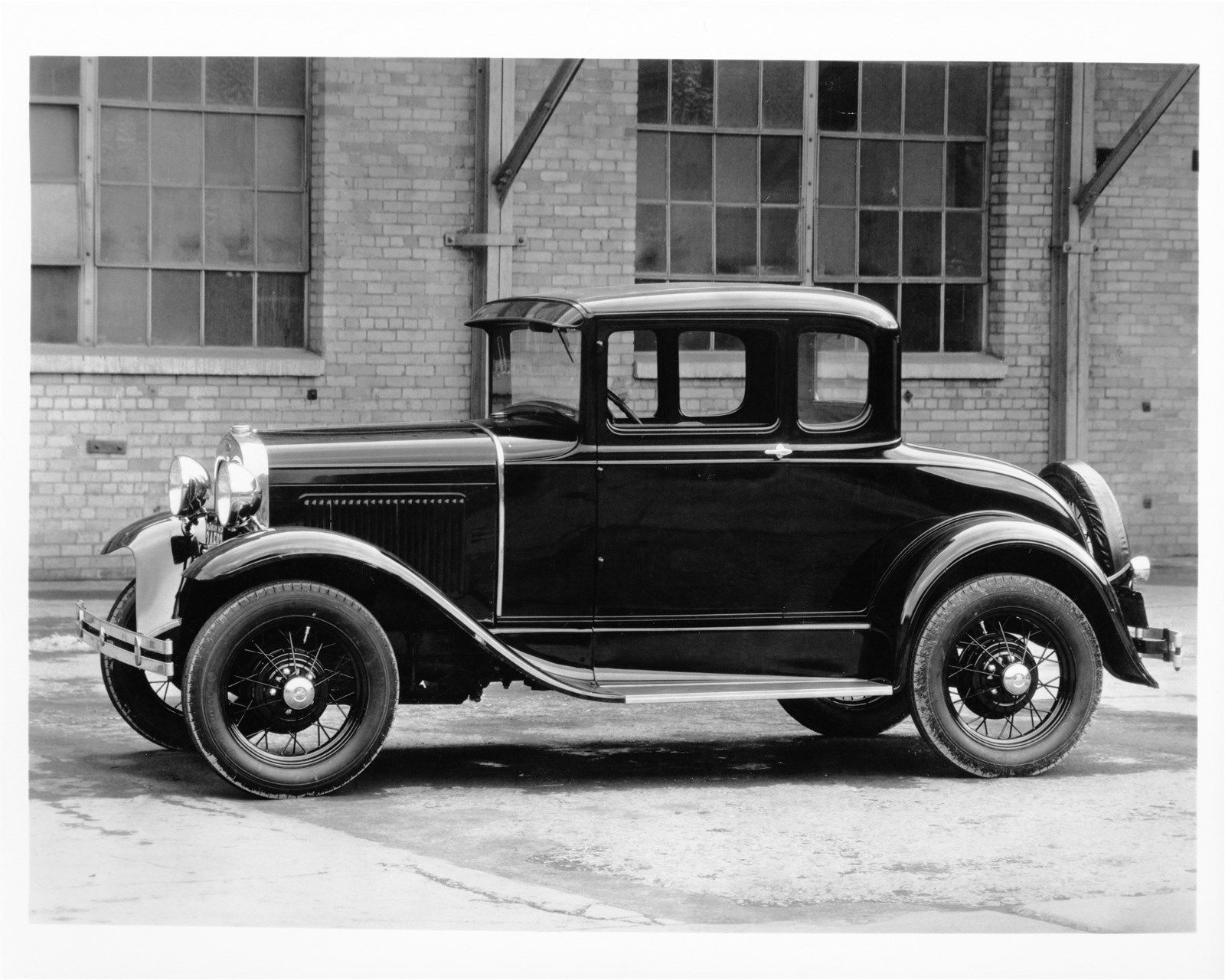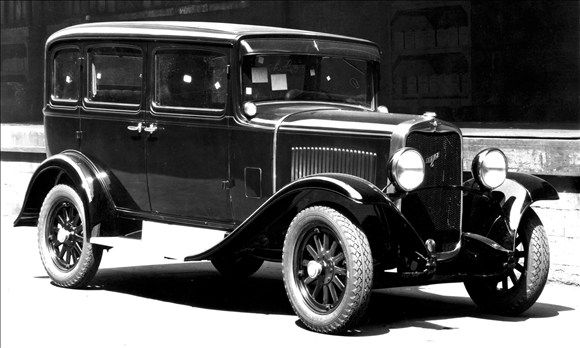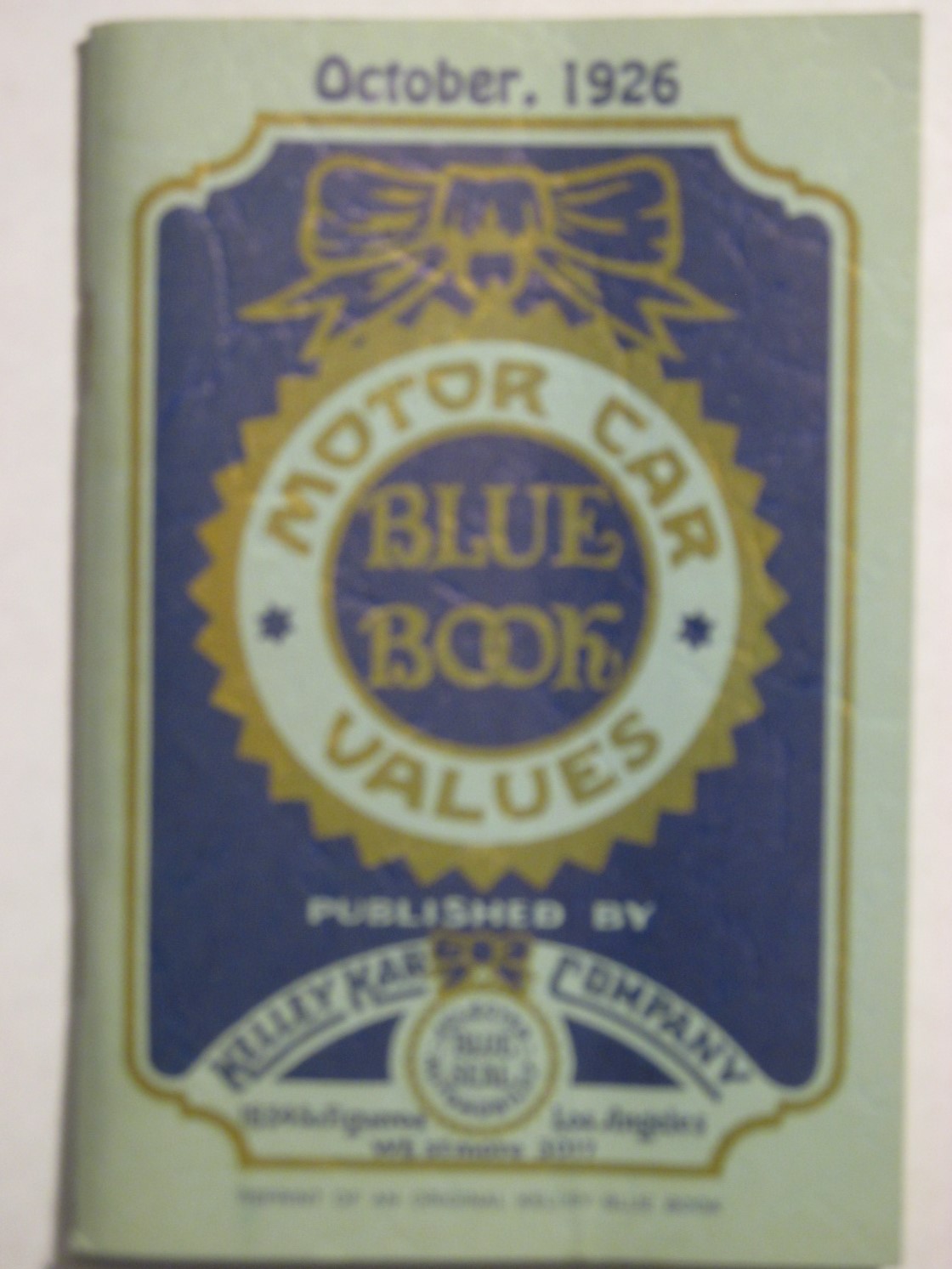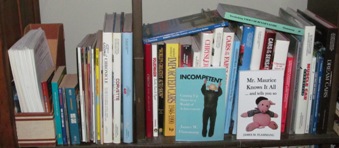Trouble lay ahead for the new-car trade. "By the start of the Golden 1920s," Business Week magazine explained many years later, "the industry had learned how to build cars; now came the period when it learned to sell them."
The auto industry faced twin threats: overproduction of new cars, and possible market saturation. Steps had to be taken, as the decade progressed, to dispose of the growing glut of both new and used automobiles.
Late in the 1890s, when cars were rarities, the notion that it was proper to produce as many goods as possible had begun to flower. Naturally, this process required that the boosted output ultimately be sold, regardless of the actual need for the products.
Next came the first predictions (as early as 1910) that the automobile market was close to saturation. Everyone who needed or wanted a car, critics claimed, already owned one. That was hardly true at the time, but the automakers displayed little concern until the 1921 economic depression burst into play.
By 1923, some thought the saturation point to be at hand. Some, in fact, had predicted such a saturation point a decade earlier; whereas the optimistic in the industry came to that view later, if at all.
During a 1925 meeting of the National Automobile Dealers Association, Charles W. Nash (later head of the company bearing his name) insisted that the saturation point had been reached two years previously. He considered the used car to be the greatest menace to the auto industry, and warned dealers not to overbid for trade-in cars – a practice which was evidently commonplace by the mid-20s.
What was this overbidding? In their zeal to increase new-car sales, dealers would offer a little more – or a lot more – than the car to be traded in was actually worth on the market. Obviously, this cut deeply into the dealer's profit margin. More new cars could be sold, it's true; but with less profit per sale, and more money tied up in used cars rather than appearing as much-needed cash.
In the mid-1920s, GM dealers were getting a 24 percent discount on the new cars they purchased from the factory; Ford, just 17 percent. Neither then nor now was the difference between wholesale and ultimate selling price as great as many customers seem to believe. There's always been room for maneuvering and dickering, but within limits.
Salesmanship was becoming a major factor in the auto business, as well as nearly every other endeavor. Dealers now had to learn how to sell all those cars that cluttered their lots and showrooms.
The dealer's plight was intensified by the quotas he had to maintain to keep his new-car franchise, coupled with the battle to dispose of all the trade-ins he received. That troubling situation applied not only to brand-new cars, but to newer used ones, purchased by less-affluent customers seeking an upgrade.
Quotas had been introduced by Ford in 1911, so dealers had to push hard. They became an industry pattern in the 1920s. You don't meet your quota? Then, your franchise is in jeopardy.
Because relatively few technical advances appeared in the 1920s, dealers had to concentrate on intangibles, appealing to the buyers' emotions, pushing comfort and pleasure. Promises made for automobiles went far beyond the mundane need for getting from one place to another. Four-wheel brakes and low-pressure balloon tires might tempt the technically-minded, but advertisements could call from a far broader palette of appeals when style and emotion were the primary factors to be promoted.

Not that technology was stagnant. A number of significant technical advances had appeared by the mid-1920s, including high-compression engines (higher than before, at any rate) and "wishbone" front suspensions. While none of these would in and of themselves attract the large numbers of new buyers needed to absorb high production, they doubtless made some difference. Even though advertising appeals had shifted to non-technical matters, news of technical advances did get to the public eventually.
When Ford launched its Model A (above left) as a 1928 successor to the unique, down-to-basics Model T, its personality changed completely. Now, instead of occupying a veritable world of its own, a Ford was similar to most of the low- to mid-priced family cars on the market: Dodge (below right), Plymouth, Chevrolet, and a dizzying number of other choices for the buying public.

A 1924 Chevrolet ad claimed that the car was "a personality multiplier, a time doubler" that would hasten the arrival of "success." An approach not unlike the ads for personal computers, much later in the century. This was the beginning of the age of marketing, and advertising's fresh purpose was to create needs, as well as to provide the promise of wondrous delights to the wide-eyed potential consumers of the nation.
On a more practical note, a Ford ad in the same year (1924) boasted that a car would boost one's "earning power." How? "By stimulating good health and efficiency." There was actually some truth to this claim. Studies revealed that many automobiles brought undreamed-of mobility to workers who could scan a wider radius in search of work, and that many found ways to secure odd jobs and other means of earning extra cash by having a car available.
Examples of the new emphasis on appearance over function, such as Chevrolet's Art & Color Division, played a significant role. Most notable was the emergence in 1927 of "planned obsolescence" (a 3-year styling cycle), introduced by General Motors. Not only did that way of looking at cars revolutionize the auto trade, but the concept soon expanded into marketing of so many other commodities.
GM head Alfred Sloan made the automakers' position quite clear when he stated that new models were being introduced each year because "We want to make you dissatisfied with your current car so you will buy a new one, you who can afford it." And with the expansion in time payments, supposedly even greater numbers than ever before could somehow "afford" one, and be induced into wanting it.
To move their new cars, dealers offered disastrous over-allowances: giving more for a trade-in than the vehicle was worth (a practice that would persist for decades). Such price manipulation resulted in an overabundant and overvalued stock of used cars jamming the lots. By 1925, a dealer expected to handle four used cars for every new one, and each car in the sequence would have to be sold before he derived his profit.
Inflated trade-in allowances started in the teens, encouraged by the manufacturers. Ford was the last to condone them. Up to 1926, Ford thought used cars should make a profit.
As described in Chapter 7, this used car "problem," inevitable since the mid-teens, became severe by the mid-1920s, peaking toward decade's end. Factories had always insisted it was a "dealer problem," and only reluctantly took action to aid their franchised dealers.
As part of the new emphasis on marketing, the period following World War I has often been considered the Age of the Salesman. It actually began before the entry of the U.S. into the international conflict, but soon became a theme of the "Roaring Twenties."
Graphic descriptions of high-pressure sales techniques had been appearing in print since the early Teens, descended from methods pioneered back in the 1880s. Those tactics were carefully refined by, and during the Twenties, undertaken by experts in creating interest and demand. Scientific salesmanship and comprehensive sales training/management strived to replace the outmoded "personality" selling.
At the same time, such methods as offering demonstration rides grew in popularity. In the mid-Twenties, demo rides conducted by salesmen were advocated by General Motors. Previously, it had been uncommon for a salesman to bring a car to a prospect's home and even to take the family out for a lengthy spin, not merely a quick trip around the block at the dealer's.
No longer was it enough to sell what was needed by the public; you had to dispose of any surplus inventory. As one historian declared, "the comparatively gentlemanly selling of the past [changed] to the frantic imperative of getting rid of excess production." Two separate sales methods had to work together: one for new cars, plus the more recent techniques developed for secondhand models. Both the auto industry and its used-car partners had to learn how to sell hard, and to sell efficiently.
Development of the dealer system, along with refined methods of training and paying salesmen also took place in the Twenties. Salesmen's duties changed markedly, from simple selling of merchandise that might be needed and desired by prospects, to disposing of that excess production. That was becoming the norm in industry. It would necessitate extreme techniques in the salesman's day-to-day methods, augmented by high-power training and strong supervision.
You're not selling a car, salesmen were taught, you're selling intangible satisfactions. It's not merely a mechanism, a practical device to get from point A to point B. Instead, you promise pride of ownership, the pleasure of pleasing someone you care about with affection, the possibility of adventure, and the satiation of curiosity about the world around you. You're also satisfying what is perceived as every person's desire for "the latest thing."
That concept of selling the "sizzle," enunciated by super-salesman Elmer Wheeler in his books on salesmanship many years later, was already the watchword of the go-getter Twenties car salesman.
Appeals were made even to a person's inherent laziness by stressing the comfort and luxury that might be received from this new (or top-notch used) automobile. The prospect could be warned that the old bus might not be safe enough for the little ones, and a cautious man naturally wants to ensure his family of safety on the road. Utilitarian appeals were still employed, such as dependability, fuel economy, and performance – but they were by no means at the top of the list, when a customer faced the new breed of salesman.
Gaudy, flamboyant used-car lots sprouted in the 1920s, and remained – though not reaching their apex of excesses until the period of early postwar prosperity, three decades later. By 1929, open-air salesrooms were beginning to replace some of the earlier dark, dusty lots and warehouse-style display areas – one of many attempts to attract more prospects.
"Blitz" techniques also sprung up: bright lights, promotions, contests, and whatever else the imaginative dealer might come up with. No more dark, dusty lots or warehouse-like display areas. The effective dealership salesroom should be brightly lit, a pleasure to enter.
One way to increase sales of used vehicles was to promote the notion of getting more for your money. A 1929 advertisement enumerated some of the desirable factors, including:
• Buying un-used transportation
• Not losing on depreciation, which could amount to a lot
• Lower initial expenditure – and monthly outlay from the family budget
• Cheaper insurance for fire and theft (no mention of liability/property damage)
• You could get expensive extras and accessories at no extra cost
• You could buy two used cars for the price of a new one
• The used car is already broken in – much more of a consideration in those days than it would be now, since correct break-in procedures were critical
• Any servicing needed for the car when it was new has already been taken care of
• Being aware of the fact that most other cars on the road are as old as this one anyway – the percentage of new models at any given time is small
• And most important, you've been sensible and economical in making your purchase
In 1927, the National Automobile Dealers Association warned dealers that they're not just in the new-car business: the used car is part of the whole transaction, whether they like it or not.
As suggested in the previous chapter, the thinking in the trade around 1929-30 was: get rid of the junkers, and concentrate on late models. It's fine if people keep their old cars around the house for utility purposes, but not at all desirable if they are cluttering up dealership sales lots. Many of the two-car families, after all, own one new (or late model) auto and one near-junker, so not all of the decrepit autos are about to be disposed of by any scrapping plans.
Studebaker Executive Shares Ideas on Used Cars
Paul G. Hoffman, later president of Studebaker (1935-48), enunciated the rising need for herculean efforts in increasing sales of used cars in his 1929 book. To begin with, he believed the commonly used Red & Blue book prices to be ultraconservative, insisting that a dealer should be able to sell for 50 percent more than the "book" price when employing the proper approach. Unlike many others, he advocated the practice of over-allowances on trade-ins, which had been a feature (or plague) of the trade for some years already – provided they were intelligently made.
 Conditioning (later called reconditioning) of used cars for sale was crucial in Hoffman's view, as in those of most marketing experts. Conditioning expense could easily amount to one-third of the ultimate selling price – but was considered well worth the investment, provided the car would indeed be salable later and was in acceptable shape to start with.
Conditioning (later called reconditioning) of used cars for sale was crucial in Hoffman's view, as in those of most marketing experts. Conditioning expense could easily amount to one-third of the ultimate selling price – but was considered well worth the investment, provided the car would indeed be salable later and was in acceptable shape to start with.
Hoffman was one who felt the transaction should take the form of a ceremony, because the trade-in car is so supremely important to its owner, just as the new (or "new" used) model will be when he gets it home. After all, that car is the man's prized possession, next to his home, and should be treated with respect rather than scorn.
Hoffman also advocated placing the actual selling price on each car's tag, not a fictitious amount or a coded figure. Not for years did this become standard practice, until the federal government finally took action after the excessive and aggressive sales practices in the Fifties. Although the honesty of that price tag is worthy of admiration, Hoffman's view of speedometer rigging is less worthy. He advocated setting each and every speedometer back to zero, in a spirit of "honesty," since the dealer could never be sure what a car's actual mileage was. True, of course, but an invariable return to zero hardly seems the proper approach to produce trustworthiness.
The ultimate goal, in Hoffman's view, was for the dealer to be a merchant, not a mere trader. He considered an operation to be sound if 1.5 used cars were being sold for each new one – a ratio that persisted for many years.
Mr. Hoffman advocated such specific marketing techniques as:
• Displaying drastic price cuts on certain cars in the showroom
• Having one car for sale at 99 cents or some such absurd figure (just to draw in the boys)
• Posting circulars all around town
• Placing cars on display at a farmers' marketplace or in front of a local factory gate, rather than solely in the showroom
• Offer a five-day trial, coupled with a 30-day guarantee
Other gimmicks included letting the prospect select the color with which the car would be repainted. (In those days, a full repaint was considered standard practice in reconditioning nearly any used car.) One dealer conducted an archery contest, whereby the winner got a refund of the purchase price for his car. Such foolishness persisted among used-car dealers for years to come, and the remnants are still seen today in certain merchandising tactics. Some are harmless; others, sadly, lean closer to trickery and deceit.
Just fix 'er up a bit ...
By the mid-teens, many companies had comprehensive rebuilding departments, to go over the old cars taken in trade, which were then sold with a guarantee. Repair and overhaul costs could easily amount to between 10 and 25 percent of the car's original list price.
In the early Twenties, dealers were getting into reconditioning as standard practice, and had come to recognize the desirability of having separate new- and used-car departments. Reconditioning in those days was no small matter. It really meant a thorough going-over of the car, not a quickie touchup and minor repairs. It could even amount to stripping the car down to its frame, inspecting every nut and bolt and component, replacing everything that showed any kind of flaw.
In some cases, a crankshaft might even be rebalanced, and cracked parts welded. Not all reconditioning operations were so thorough, of course, but the term generally meant a good deal more than it would in later years (or does today).
Click here for Overview: Casual History of the Used Car
Click here for Chapter 1: Early Days - Rich Men's Playthings, Poor Men's Dreams
Click here for Chapter 2: Ford's Model T and the Masses
Click here for Chapter 3: Production and Prosperity
Click here for Chapter 4: "Easy" Payments
Click here for Chapter 5: Family Cars and Family Life
Click here for Chapter 6: Five-Dollar Flivvers
Click here for Chapter 7: Rise and Fall of the Used Car
Click here for Chapter 9: A Global Blowout
Click here for Chapter 10: Selling in Hard Times
Click here for Chapter 11: Wheels for the Workingman
Click here for Chapter 12: Okies, Nomads, and Jalopies
Click here for Chapter 13: Motoring in Wartime
Click here for Chapter 14: The Postwar Boom
Click here for Chapter 15: Chromium Fantasies
Click here for Chapter 16: Dealers Face Image Problem
Click here for Chapter 17: Wheels for the Fifties Workingman
Click here for Chapter 18: Teens, Rods, and Clunkers
Click here for Chapter 19: Everybody Drives
Click here for Chapter 20: Personal History of Clunker Ownership



